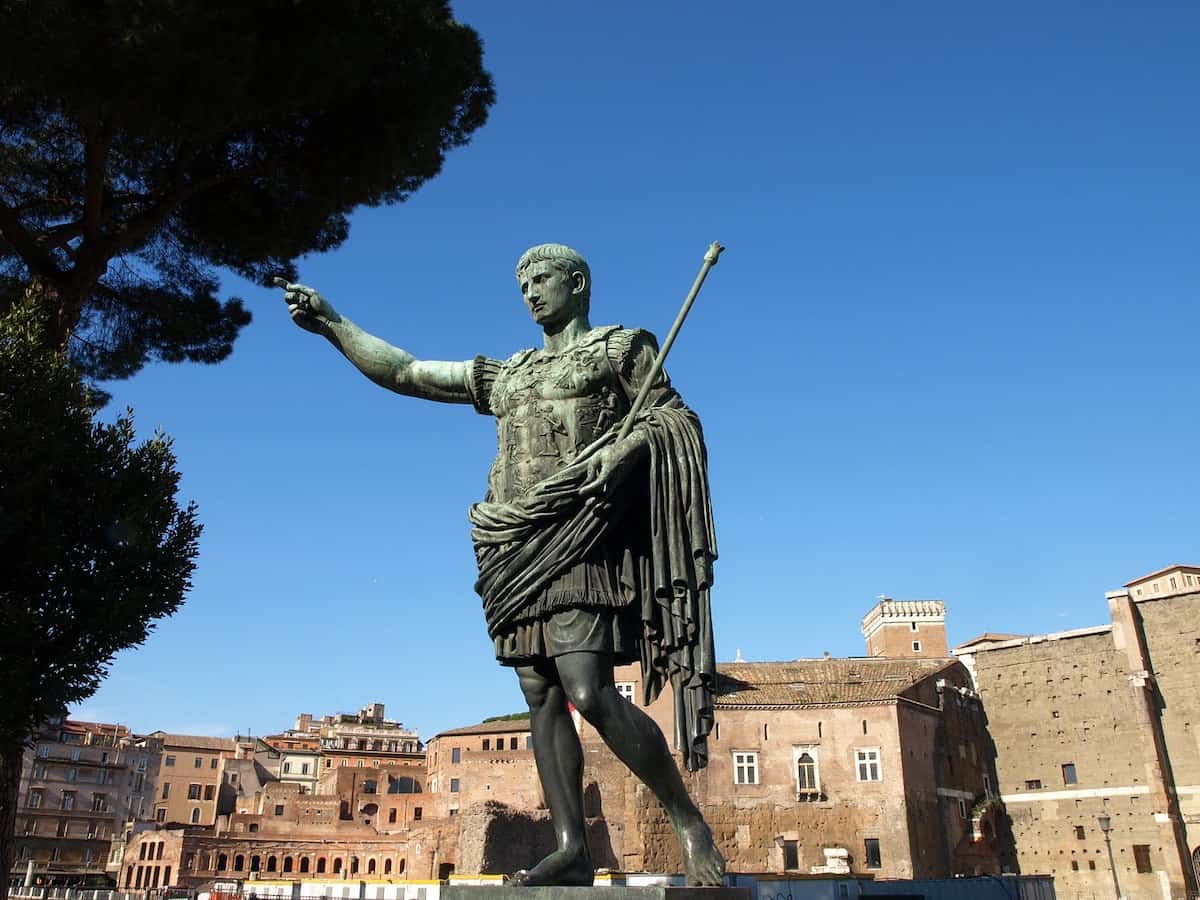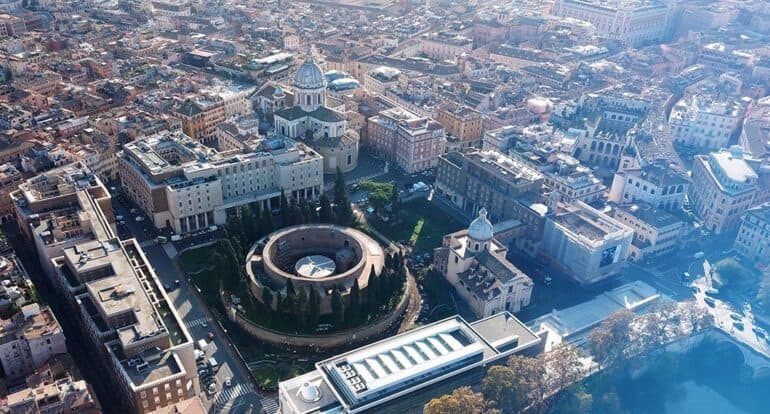The largest circular tomb in the world reopens after intense restoration works
The founder of the Roman Empire, emperor Augustus Caesar, filled Rome with monuments recalling his victories. Among the many architectural landmarks built, one of the most significant monuments still standing in Rome is the Mausoleum of Augustus. This architectural landmark used to be one of the most beloved and enduring icons of the city, not to mention the largest circular tomb monument in the world, with a diameter of 87 meters.
I found Rome a city of bricks and left it a city of marble.
– Augustus Caesar
Built in 28 BC as the first dynastic sepulchre in Rome, this tomb is one of the most well-known monuments in the Roman Empire and worldwide. So much so that after 80 years of being closed, the Italian telecommunications company TIM has donated €8 million to restore the Mausoleum.
We’re happy to announce that from March 1st 2021, the Mausoleum of August has reopened again! Visits of the Mausoleum last around 50 minutes and take place from Monday to Friday from 9am till 4pm. Till April 21st visits to the Mausoleum will be free of charge for everyone while from April 22nd till the end of 2021, visits to the Mausoleum will be free of charge for all residents of Rome.
The museum complex itinerary tells the history of the Mausoleum, divided into different historic periods. From 22 April 2021visits to the Mausoleum will be enriched with digital content, virtual and augmented reality, in collaboration with Fondazione TIM.
History of the Mausoleum of Augustus

The Mausoleum of Augustus was the first of many significant building projects undertaken during the reign of Rome’s first emperor. Built in 28 BC, the mausoleum of Augustus is the funerary monument of Gaius Octavius, the emperor who, with the victory of Actium, put an end to the era of civil wars in Rome and consolidated the Roman Empire. Octavian began construction in the Campus Martius in 28 BC, a few years after the end of the war against Antony and the conquest of Egypt. The construction was inspired by the Hellenistic-style tomb of Alexander the Great, also with a circular plan, and the Mausoleum of Halicarnassus (modern Bodrum), built around 350 BC. in honor of King Mausolus. The Mausoleum of Augustus was the most immense tomb in the Roman world, a gigantic white construction surrounded by trees and with a bronze statue of Augustus at the top. But what led to its abandonment over the eras?
“Use technology to travel with your imagination.
– TIM Fondazione.
The Mausoleum of Augustus was used as a burial site for the relatives and descendants of Augustus for only one century, up until the later emperors abandoned it and started building tombs of their own. In 410 A.D. during the siege of the Goths, the tomb was deprived of its most precious objects, and with the fall of the Roman Empire, the Mausoleum became a church and later, the Colonna family had the Mausoleum fortified and turned into a castle-fortress. Unfortunately it was then sacked and its statutes, materials and marbles were reused to build other monuments and buildings.
The Mausoleum kept on changing ownership and purpose, from an Italian style garden to an amphitheatre for bullfights, from theatre to the most famous music hall in Europe. Up until during the Fascist period, Mussolini decided to restore the monument. The restoration project was divided into various phases, the first of which included demolishing the buildings that had been erected on top of the Mausoleum over the centuries. With the break out of the Second World War, the restoration works were interrupted. The tomb was closed to the public until in 2007, new archeological excavations were made and in 2016 a new restoration project began, with the objective of giving this stunning monument its deserved place in Rome’s historic center.
The Restoration Project
Once the conservative restoration phase of the Mausoleum was completed in 2019, carried out through a public funding of €4,275,000 (2 million paid by Mibact and €2,275,000 by Roma Capitale), the enhancement phase of the monument is currently underway thanks to the allocation of €8 million funded by the TIM Foundation.
The restoration project was divided into two phases: the consolidation of existing structures to make them safe and accessible, and the enhancement that allowed a new use for the installation. To consolidate the structure, reconstructions were needed to prevent any new damage or collapse. The first task was to transfer 153 ancient archaeological remains. Once the project was completed, they returned to the Mausoleum. The cleaning, filling, and shielding has made it possible to get rid of the vegetation that had taken root on the walls. And to stop future water penetration inside the masonry, the buildings’ surface was coated with a thick protective barrier. A shield against rain has also been installed.
Not to be missed

Visiting the Mausoleum of Augustus allows you to take a journey through time. While it isn’t easy to identify the single eras contained in the fascinating monument, the variety of historical traces belonging to different time periods encountered in the maze of rooms, stairs and corridors is truly surprising. The most interesting element of the Mausoleum is surely the burial chamber that housed the urns with the ashes of the relatives of Augustus.
In this chamber, where around 2000 years ago we would’ve walked on a floor of travertine slabs, the Emperor’s urn was most probably located in the central cylinder, which corresponds to the statue at the top. The only remains we see today are those of the urn of Octavia, Augustus’s sister – you can still see the traces of the pickaxes used while attempting to destroy it in the Middle Ages.
An unusual view of Piazza Augusto Imperatore

The visit to the Mausoleum also allows you to admire Piazza Augusto Imperatore from an unusual point of view, from the Ara Pacis. This square, with its three INPS buildings, the church of San Rocco and that of San Carlo al Corso, is destined to become a large public space which, in 2022, will host the first Bulgari Hotel in Rome.
INSPIRATION
Touristy But Worth It: The Must-See Attractions In Rome
Who was Augustus Caesar?

Augustus Caesar (Gaius Octavian – original name) was the first Roman Emperor, successor of Julius Caesar and one of the most significant administrative geniuses in history. The immense reorganization work he carried out transformed the collapsing republic into a modern, monarchic regime.
Augustus transformed the Roman people into builders of a glorious Empire. The Emperor gave the city important monuments and remarkable reconstructions. He wanted them to remain at the Roman people’s disposal, such as the Theatre of Marcellus, the Pantheon, the Ara Pacis solar clock on-campus Martius, the Temples of Jupiter, and the Temples of Apollo.
Rome gradually became an empire where there was an appreciation for art, theatre, poetry, architecture, and cultural activities. Not only was the Mausoleum converted into a concert hall, bull-fighting arena, and circus acts in the late 19th and early 20th-century, but it was most notably a burial site for Augustus’ family.

The original purpose of the Mausoleum was to retain relatives of this family. Those buried within it included the nephew of Augustus, Marcellus (died 23 BCE), his son-in-law, Marcus Agrippa (12 BCE), Drusus, the Elder (9 BCE), the two sons of Augustus, Lucius and Gaius Caesar (2 and 4 CE), and the Emperor himself in 14 CE. A long line of associations and spouses followed, including Drusus the Younger, Livia, Tiberius, Agrippina, Nero, Drusus (Caligula’s brother), Poppaea, and Nerva.
How to visit the Mausoleum of Augustus

You can visit the Mausoleum of Augustus by booking and purchasing your ticket on the official website. Due to Covid-19 restrictions, there is limited access to the Mausoleum – a maximum of 10 people can access the monument every hour. Till 21 April 2021 all visitors will have free entry to the Mausoleum, while from 22 April to 31 December 2021 the ticket will be free only for residents of Rome. From 22 April 2021, the visits to the Mausoleum will be enriched with digital content, virtual and augmented reality, in collaboration with Fondazione TIM.
MAUSOLEUM OF AUGUSTUS: TEMPORARY CLOSURE FROM 6 JUNE
From 6 June the Mausoleum of Augustus closes temporarily to allow the progress of the redevelopment works of Piazza Augusto Imperatore.
Piazza Augusto Imperatore
Everyday 9am – 7pm (last entry 5.30pm)
Tickets for non residents: €3 – €4 (+€1 reservation)
mandatory reservation






Great article on the Mausoleum of Augustus. Very informative as well. I’m glad that it was restored so future generations can see a part of Roman history.